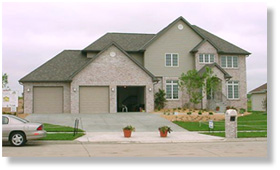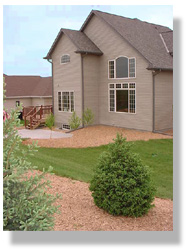

Governor Mike Johanns launched a new state effort to maximize energy efficiency and the use of recycled content materials in new home construction. The homes also incorporate state of the art building methods that reduce waste and minimize water and materials.

The state's new Nebraska Certified Green Building program was developed by the Nebraska Energy Office and the Nebraska State Home Builders over the past two years. A team of builders developed the criteria and specifications and standards appropriate for Nebraska.
"A Nebraska Certified Green Built Home is an assurance that a new home has been built to exacting energy and environmental standards established by the State of Nebraska's Energy Office and constructed by a certified builder," Governor Johanns said.
The Governor said the prototype homes under construction are used as working classrooms where new construction techniques and materials are demonstrated in "hands-on" sessions for builders, contractors and students.

"I am so pleased that this extraordinary effort has been accomplished without using any state tax funds," Johanns said. "The Energy Office loaned trust funds that will be repaid when the homes are sold." The Governor said the next series of prototype homes will cost much less and target first-time home buyers.

The Green Built house featured on the tour is estimated to save $90 a month in energy and water costs. Estimated yearly heating and cooling costs are $200. Recycled content materials and products were extensively used throughout the home including drywall, carpet, exterior decking, flooring, and shingles.
The Department of Environmental Quality provided a grant to the Energy Office to expand the scope of the Green Building effort enabling information to be accessible to Nebraskans on the Energy Office's web site.
We have arrived at the dawn of a new day in home construction in Nebraska today — a day where energy efficiency and environmental concerns are integrated into a new home from the very beginning.
Thanks to the efforts of the Nebraska Energy Office, the Nebraska State Home Builders Association, the Department of Environmental Quality and many others, new materials and new ideas are being put into homes as they're designed and constructed.
The hallmark of these homes features products manufactured from recycled materials and construction techniques that minimize waste and reduce energy costs.
Nebraska 's Certified Green Built homes, like this one, use the latest in energy efficient design, products and systems.
Today officially marks the beginning of the Nebraska Certified Green Built Home program. It's been in the works for two years, and we are here to see the results of those efforts.
In consultation with a team of builders, criteria and specifications were developed for Green Building standards appropriate for Nebraska. As a result of those efforts, three homes have been built in Lincoln using the state's standards.
What does "green built" mean for Nebraskans? Simply stated, a Nebraska Certified Green Built Home is an assurance that a new home has been built to exacting energy and environmental standards established by the State of Nebraska's Energy Office and constructed by a certified builder.
How is a Nebraska Certified Green Built Home different?
First, the home has earned a five-star energy rating.
Second, the home was built by a certified contractor and has features that make it healthier and more comfortable while reducing energy use and its impact on the environment.
One of the key features of this home is water conservation. Throughout this home, water saving elements — think of them as drought busters — are employed. Every effort has been made to reduce water consumption.
Building green, also means keeping more green in Nebraskans' pockets. The new owners of this home will save about $90 dollars a month compared to a traditionally built home.
While under construction, the three Green Built homes have been used as working classrooms where new construction techniques and materials were demonstrated in "hands-on" sessions for builders and subcontractors as well as tomorrow's builders, students and faculty from Southeast Community College.
Because of a Department of Environmental Quality grant, Nebraskans who want to use products and features that reduce waste or have recycled content can find those items listed on the Energy Office's web site. Dozens of home construction and water-saving landscaping techniques are there as well.
I can promise you that there will be more Nebraska Certified Green Built homes built, and more certified home builders will be trained.
The good news is that the next group of Nebraska Certified Green Built homes to be constructed will cost even less and target first-time homebuyers.
Let me add that I'm so pleased that this extraordinary effort has been accomplished without using any state tax funds.
The Energy Office loaned trust funds that will be repaid so that more prototype homes can be constructed. The funds from the Department of Environmental Quality came from litter reduction fees.
Now, I would like to take this opportunity to recognize the state's first three Certified Builders and give them the Nebraska Certified Green Building plaques.
The first three Nebraska Certified Builders are:
I would like to personally thank these individuals for stepping up to volunteer their time and expertise to bring new construction techniques that emphasize energy efficiency and environmental concerns to Nebraska homebuyers.
I also want to recognize Lynn Chamberlin, staff architect for the Energy Office, who led the development of the Nebraska Certified Green Built Home program. Lynn designed the house on today's tour, and she will be happy to answer any questions you may have.
Before you leave today, I hope all of you will take time to go through the house to notice the details that make it special.
For all of you that have a part in the development of Nebraska's Certified Green Building program, I extend my deepest thanks.
Note: Governor Johanns also recognized the state's first seven Certified Homebuilders at the event.
The "New Construction" section at the Energy Office's web site is a "one stop shop" that contains an ever-expanding array of products, techniques and information on how homes and other buildings can be made more energy and resource efficient when they are first built.
Dozens of methods for utilizing resource efficient building techniques are listed in this section. Diagrams of the construction details are available in either HTM, PDF or DWF formats. Home Construction Design Details
A number of issues related to new home construction are addressed in this section. The information is available in HTM or PDF format. Home Design & Build Issues
This section contains nearly 200 products used in building construction that contain recycled content or utilize sustainable resources. Below is a list of types of building materials, systems and interior products that have varying percentages of recycled content. Click on the items in the Recycled Content list below to find sub-classifications of construction materials with links to specific product literature. When available, the amount and types of recycled materials in each product is identified with numbered symbols so that those products with higher percentages of recycled content can be easily located. (Some categories are incomplete)